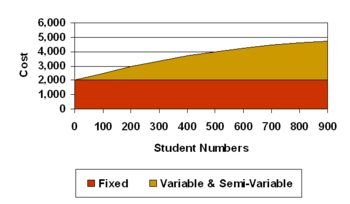Economies of Scale
| Unit 2 |
Introduction | Review of Fixed, Variable and Semi-Variable Costs | Total Costs | Average Costs | Economies of Sale | Costs of ODL versus Conventional Education | Questions for Consideration |
Often, total costs do not continue rising in a straight line as student numbers increase. This is because they are a mix of fixed costs, variable costs and semi-variable costs.
Take, for example, the cost of reproducing a print-based study guide. Part of this expenditure is made up of paper and ink, which are variable costs that increase in direct proportion to each additional copy made. Although a certain amount of human labour is required for each copy, the bulk of the operator’s time is spent setting up the machine for the print run and this is a semi-variable cost. Finally, all of the costs associated with developing the materials to the stage where they are ready for printing are fixed, regardless of the number of copies made. When we combine all these variable, semi-variable and fixed costs, however, we find that the rate of increase in total costs tends to level off as student numbers grow. This can be seen in the curved line that bounds the mustard-coloured area in Figure 2d below:
When we consider the average cost per booklet, this will tend to be higher when a small number of booklets are printed, because the fixed and semi-variable costs of production are shared among relatively few students. By way of contrast, when many booklets are printed, the fixed and semi-variable costs are spread among a larger number of units. As a result, total expenditure on the course will continue to grow, but not at the same rate as before.
In addition, the average cost per booklet will actually decrease. In this example, if 200 students enrol for the course, the average cost per booklet will be ZAR 15.00 (total costs of ZAR 3,000 divided by 200 students). If 800 students are registered, the average cost per booklet will fall to less than ZAR 6.00 (total costs of ZAR 4,600 divided by 800 students).
|
When the cost of producing an additional unit of output of a good or service decreases as the volume of output (the scale of production) increases, this is referred to as an economy of scale. |
